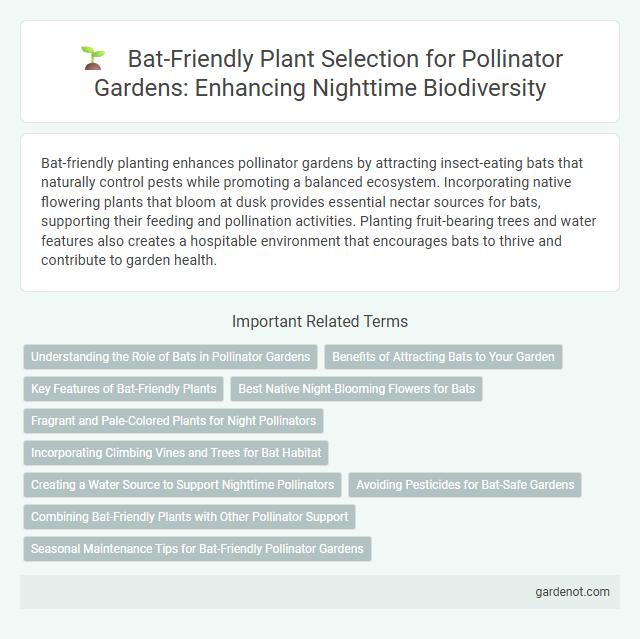Bat-friendly planting enhances pollinator gardens by attracting insect-eating bats that naturally control pests while promoting a balanced ecosystem. Incorporating native flowering plants that bloom at dusk provides essential nectar sources for bats, supporting their feeding and pollination activities. Planting fruit-bearing trees and water features also creates a hospitable environment that encourages bats to thrive and contribute to garden health.
Understanding the Role of Bats in Pollinator Gardens
Bats play a crucial role in pollinator gardens by facilitating the pollination of night-blooming plants such as agave and cactus, which are essential species for maintaining biodiversity. Their nocturnal feeding habits complement daytime pollinators, ensuring a continuous pollination process that supports a wide range of flora. Incorporating bat-friendly plants and creating habitats that attract bats can enhance pollination efficiency and promote ecosystem health.
Benefits of Attracting Bats to Your Garden
Attracting bats to your pollinator garden enhances natural pest control by reducing mosquito and insect populations, promoting healthier plant growth without chemical pesticides. Bats contribute to biodiversity by pollinating various night-blooming plants, aiding in seed dispersal and ecosystem balance. Creating bat-friendly habitats with native plants and water sources supports their survival, boosting pollination efficiency and garden resilience.
Key Features of Bat-Friendly Plants
Bat-friendly plants provide essential nectar, fruit, and insects that sustain diverse bat species, promoting nocturnal pollination and pest control. Key features include strong night-time scent emissions, white or pale-colored flowers visible in low light, and dense foliage offering shelter and roosting sites. Incorporating native bat-attracting plants like agave, evening primrose, and gum trees enhances biodiversity and supports healthy bat populations in pollinator gardens.
Best Native Night-Blooming Flowers for Bats
Bat-friendly planting enhances pollinator gardens by incorporating native night-blooming flowers such as Evening Primrose, Night-Blooming Jasmine, and Moonflower, which provide essential nectar for nocturnal pollinators. These native species support local bat populations by offering abundant food sources and habitat, promoting ecosystem health and biodiversity. Selecting plants that bloom at night ensures continuous nectar availability, critical for sustaining bat activity and supporting pollination processes.
Fragrant and Pale-Colored Plants for Night Pollinators
Bat-friendly pollinator gardens thrive with fragrant, pale-colored plants that attract nocturnal pollinators. Species such as night-blooming jasmine, moonflowers, and evening primrose release strong scents and display white or light-hued blossoms visible under low light, enhancing bat foraging efficiency. Incorporating these plants supports bat populations by providing essential nectar sources during night hours, bolstering overall ecosystem health.
Incorporating Climbing Vines and Trees for Bat Habitat
Incorporating climbing vines like trumpet vine and native trees such as oaks creates essential roosting and foraging habitats for bats in a pollinator garden. These plants provide shelter and abundant insect prey, supporting bat populations crucial for natural pest control. Prioritizing bat-friendly vegetation enhances biodiversity and strengthens ecosystem health through effective nocturnal pollination.
Creating a Water Source to Support Nighttime Pollinators
Designing a bat-friendly pollinator garden involves incorporating a clean, shallow water source such as a birdbath or small pond with gentle slopes to provide easy access for bats to drink without risk. Nighttime pollinators like bats rely on water proximity for hydration during their active hours, enhancing their pollination efficiency. Including native plants around the water feature supports insect populations, ensuring a sustainable food supply for bats and promoting biodiversity.
Avoiding Pesticides for Bat-Safe Gardens
Bat-friendly planting enhances pollinator gardens by incorporating native flowering plants and fruit-bearing trees that provide natural food sources for bats. Avoiding pesticides is critical in creating bat-safe gardens, as chemical exposure can disrupt bat navigation and reduce insect prey populations vital for their diet. Implementing organic pest control methods fosters a healthy ecosystem, supporting biodiversity and sustaining effective pollination services.
Combining Bat-Friendly Plants with Other Pollinator Support
Incorporating bat-friendly plants such as night-blooming jasmine and agave with nectar-rich flowers like milkweed and coneflowers enhances habitat diversity in a pollinator garden. This combination supports nocturnal pollinators like bats alongside daytime species including bees and butterflies. Strategic planting of these species creates a balanced ecosystem, promoting pollination and biodiversity throughout the day and night.
Seasonal Maintenance Tips for Bat-Friendly Pollinator Gardens
Seasonal maintenance of bat-friendly pollinator gardens includes clearing leaf litter in late fall to minimize pest habitats while leaving some undisturbed areas for bat roosting. Pruning native flowering plants in early spring promotes fresh blooms and supports insect populations essential for bat diets. Regularly checking water sources and ensuring they remain clean and accessible throughout summer sustains hydration needs for bats and other pollinators.
Bat-friendly planting Infographic

 gardenot.com
gardenot.com